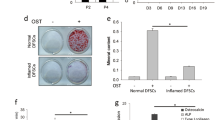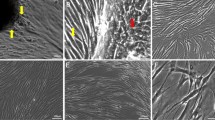Abstract
Follicular dendritic cell-secreted protein (FDC-SP) is secreted protein expressed in follicular dendritic cells, periodontal ligament and junctional epithelium (JE). Its expression could be controlled during inflammatory process of gingiva; however, responsible mechanism for gingival overgrowth and involvement of FDC-SP in clinical condition is still unclear. We hypothesized that JE-specific genes are associated with the initiation of drug-induced gingival enlargement (DIGE) called gingival overgrowth, and investigated the changes of JE-specific gene’s expression and their localization in overgrown gingiva from the patients. Immunohistochemical analysis revealed that the FDC-SP localization was spread in overgrown gingival tissues. FDC-SP mRNA levels in GE1 and Ca9-22 cells were increased by time-dependent nifedipine treatments, similar to other JE-specific genes, such as Amelotin (Amtn) and Lamininβ3 subunit (Lamβ3), whereas type 4 collagen (Col4) mRNA levels were decreased. Immunocytochemical analysis showed that FDC-SP, AMTN, and Lamβ3 protein levels were increased in GE1 and Ca9-22 cells. Transient transfection analyses were performed using luciferase constructs including various lengths of human FDC-SP gene promoter, nifedipine increased luciferase activities of -345 and -948FDC-SP constructs. These results raise the possibility that the nifedipine-induced FDC-SP may be related to the mechanism responsible for gingival overgrowth does not occur at edentulous jaw ridges.








Similar content being viewed by others
References
Sorkin EM, Clissold SP, Brogden RN. Nifedipine. A review of its pharmacodynamic and pharmacokinetic properties, and therapeutic efficacy, in ischaemic heart disease, hypertension and related cardiovascular disorders. Drugs. 1985;30:182–274.
Corrêa JD, Queiroz-Junior CM, Costa JE, Teixeira AL, Silva TA. Phenytoin-induced gingival overgrowth: a review of the molecular, immune, and inflammatory features. ISRN Dent. 2011;2011:497850.
Faulds D, Goa KL, Benfield P. Cyclosporin. A review of its pharmacodynamic and pharmacokinetic properties, and therapeutic use in immunoregulatory disorders. Drugs. 1993;45:953–1040.
Uzel MI, Kantarci A, Hong HH, Uygur C, Sheff MC, Firatli E, Trackman PC. Connective tissue growth factor in drug-induced gingival overgrowth. J Periodontol. 2001;72:921–31.
Black SA Jr, Palamakumbura AH, Stan M, Trackman PC. Tissue-specific mechanisms for CCN2/CTGF persistence in fibrotic gingiva: interactions between cAMP and MAPK signaling pathways, and prostaglandin E2-EP3 receptor mediated activation of the c-JUN N-terminal kinase. J Biol Chem. 2007;282:15416–29.
Thompson K, Hamilton DW, Leask A. ALK5 inhibition blocks TGFß-induced CCN2 expression in gingival fibroblasts. J Dent Res. 2010;89:1450–4.
Sume SS, Kantarci A, Lee A, Hasturk H, Trackman PC. Epithelial to mesenchymal transition in gingival overgrowth. Am J Pathol. 2010;177:208–18.
Hormia M, Owaribe K, Virtanen I. The dento-epithelial junction: cell adhesion by type I hemidesmosomes in the absence of a true basal lamina. J Periodontol. 2001;72:788–97.
Bosshardt DD, Lang NP. The junctional epithelium: from health to disease. J Dent Res. 2005;84:9–20.
Hormia M, Sahlberg C, Thesleff I, Airenne T. (1998) The epithelium-tooth interface—a basal lamina rich in laminin-5 and lacking other known laminin isoforms. J Dent Res. 1998;77:1479–85.
Goldfinger LE, Hopkinson SB, deHart GW, Collawn S, Couchman JR, Jones JC. The alpha3 laminin subunit, alpha6beta4 and alpha3beta1 integrin coordinately regulate wound healing in cultured epithelial cells and in the skin. J Cell Sci. 1999;112:2615–29.
Aron JM, Quijiang D, Kevin ED, Yasufumi S, Kent T, Hay G, Edward AC. FDC-SP, a novel secreted protein expressed by follicular dendritic cells. J Immunol. 2002;169:2381–9.
Hou S, Landego I, Jayachandran N, Miller A, Gibson IW, Ambrose C, Marshall AJ. Follicular dendritic cell secreted protein FDC-SP controls IgA production. Mucosal Immunol. 2014;7:948–57.
Oshiro A, Iseki S, Miyauchi M, Terashima T, Kawaguchi Y, Ikeda Y, Shinomura T. Lipopolysaccharide induces rapid loss of follicular dendritic cell-secreted protein in the junctional epithelium. J Periodontal Res. 2012;47:689–94.
Takahashi S, Fukuda M, Mitani A, Fujimura T, Iwamura Y, Sato S, Kubo T, Sugita Y, Maeda H, Shinomura T, Noguchi T. Follicular dendritic cell-secreted protein is decreased in experimental periodontitis concurrently with the increase of interleukin-17 expression and the Rankl/Opg mRNA ratio. J Periodontal Res. 2014;49:390–7.
Iwasaki K, Bajenova E, Somogyi-Ganss E, Miller M, Nguyen V, Nourkeyhani H, Gao Y, Wendel M, Ganss B. Amelotin–a novel secreted, ameloblast-specific protein. J Dent Res. 2005;84:1127–32.
Moffatt P, Smith CE, St-Arnaud R, Simmons D, Wright JT, Nanci A. Cloning of rat amelotin and localization of the protein to the basal lamina of maturation stage ameloblasts and junctional epithelium. Biochem J. 2006;399:37–46.
Nakayama Y, Takai H, Matsui S, Matsumura H, Zhou L, Kato A, Ganss B, Ogata Y. Proinflammatory cytokines induce amelotin transcription in human gingival fibroblasts. J Oral Sci. 2014;56:261–8.
Nakayama Y, Takai H, Matsui S, Zhou L, Abiko Y, Ganss B, Ogata Y. Transcriptional regulation of amelotin gene by proinflammatory cytokines in gingival fibroblasts. Connect Tissue Res. 2014;55(Suppl 1):18–20.
Nakayama Y, Kobayashi R, Matsui S, Matsumura H, Iwai Y, Noda K, Yamazaki M, Kurita-Ochiai T, Yoshimura A, Shinomura T, Ganss B, Ogata Y. Localization and expression pattern of amelotin, odontogenic ameloblast-associated protein and follicular dendritic cell-secreted protein in the junctional epithelium of inflamed gingiva. Odontology. 2017;105:329–37.
Nakayama Y, Kobayashi R, Iwai Y, Noda K, Yamazaki M, Kurita-Ochiai T, Yoshimura A, Ganss B, Ogata Y. C/EBPβ and YY1 bind and interact with Smad3 to modulate lipopolysaccharide-induced amelotin gene transcription in mouse gingival epithelial cells. FEBS Open Bio. 2018;27:276–90.
Nakayama Y, Matsui S, Noda K, Yamazaki M, Iwai Y, Matsumura H, Izawa T, Tanaka E, Ganss B, Ogata Y. Amelotin gene expression is temporarily being upregulated at the initiation of apoptosis induced by TGFβ1 in mouse gingival epithelial cells. Apoptosis. 2016;21:1057–70.
Nakayama Y, Tsuruya Y, Noda K, Yamazaki-Takai M, Iwai Y, Ganss B, Ogata Y. Negative feedback by SNAI2 regulates TGFβ1-induced amelotin gene transcription in epithelial-mesenchymal transition. J Cell Physiol. 2019;234:11474–89.
Somogyi-Ganss E, Nakayama Y, Iwasaki K, Nakano Y, Stolf D, McKee MD, Ganss B. Comparative temporospatial expression profiling of murine amelotin protein during amelogenesis. Cells Tissues Organs. 2012;195:535–49.
Hatakeyama S, Ohara-Nemoto Y, Yanai N, Obinata M, Hayashi S, Satoh M. Establishment of gingival epithelial cell lines from transgenic mice harboring temperature sensitive simian virus 40 large T-antigen gene. J Oral Pathol Med. 2001;30:296–304.
Gamou S, Shimizu N. Change in metabolic turnover is an alternate mechanism increasing cell surface epidermal growth factor receptor levels in tumor cells. J Biol Chem. 1987;262:6708–13.
Masaoka T, Hashimoto S, Kinumatsu T, Muramatsu T, Jung HS, Yamada S, Shimono M. Immunolocalization of laminin and integrin in regenerating junctional epithelium of mice after gingivectomy. J Periodontal Res. 2009;44:489–95.
Pritlove-Carson S, Charlesworth S, Morgan PR, Palmer RM. Cytokeratin phenotypes at the dento-gingival junction in relative health and inflammation, in smokers and nonsmokers. Oral Dis. 1997;31:19–24.
Larjava H, Lyons JG, Salo T, Mäkelä M, Koivisto L, Birkedal-Hansen H, Akiyama SK, Yamada KM, Heino J. Anti-integrin antibodies induce type IV collagenase expression in keratinocytes. J Cell Physiol. 1993;157:190–200.
Takasaki Y, Deng JS, Tan EM. A nuclear antigen associated with cell proliferation and blast transformation. J Exp Med. 1981;154:1899–909.
Guo T, Rudnick PA, Wang W, Lee CS, Devoe DL, Balgley BM. Characterization of the human salivary proteome by capillary isoelectric focusing/nanoreversed-phase liquid chromatography coupled with ESI-tandem MS. J. Proteome Res. 2006;5:1469–78.
Park SM, Park SY, Kim JH, Kang TW, Park JL, Woo KM, Kim JS, Lee HC, Kim SY, Lee SH. Genome-wide mRNA profiling and multiplex quantitative RT-PCR for forensic body fluid identification. Forensic Sci Int Genet. 2012;7:143–50.
Meng HX, Li HN, Geng JS, Ohe R, Yu XY, Ye F, Yang SR, Kato T, Zhang L, Ishida A, Ohta N, Jin XM, Kakehata S, Geng JS, Yamakawa M. Decreased expression of follicular dendritic cell-secreted protein correlates with increased immunoglobulin A production in the tonsils of individuals with immunoglobulin A nephropathy. Transl Res. 2015;166:281–91.
Okanobu A, Matsuda S, Kajiya M, Fujita T, Kittaka M, Shiba H, Kurihara H. A novel gingival overgrowth mouse model induced by the combination of CsA and ligature-induced inflammation. J Immunol Methods. 2017;445:31–6.
Brown RS, Arany PR. Mechanism of drug-induced gingival overgrowth revisited: a unifying hypothesis. Oral Dis. 2015;21:51–61.
Iwai Y, Noda K, Yamazaki M, Kato A, Mezawa M, Takai H, Nakayama Y, Ogata Y. Tumor necrosis factor-α regulates human follicular dendritic cell-secreted protein gene transcription in gingival epithelial cells. Genes Cells. 2018;23:161–71.
Yamazaki M, Iwai Y, Noda K, Matsui S, Kato A, Takai H, Nakayama Y, Ogata Y. Tumor necrosis factor-α stimulates human amelotin gene transcription in gingival epithelial cells. Inflammation Res. 2018;67:351–61.
Dannewitz B, Krieger JK, Simon I, Dreyhaupt J, Staehle HJ, Eikholz P. Full-mouth disinfection as a nonsurgical treatment approach for drug-induced gingival overgrowth: a series of 11 cases. Int J Periodontics Restor Dent. 2010;30:63–71.
Kawasaki K, Weiss KM. SCPP gene evolution and the dental mineralization continuum. J Dent Res. 2008;87:520–31.
Kawasaki K. The SCPP gene family and the complexity of hard tissues in vertebrates. Cells Tissues Organs. 2011;194:108–12.
Holcroft J, Ganss B. Identification of amelotin- and ODAM-interacting enamel matrix proteins using the yeast two-hybrid system. Eur J Oral Sci. 2011;119(Suppl 1):301–6.
Fouillen A, Dos Santos NJ, Mary C, Castonguay JD, Moffatt P, Baron C, Nanci A. Interactions of AMTN, ODAM and SCPPPQ1 proteins of a specialized basal lamina that attaches epithelial cells to tooth mineral. Sci Rep. 2017;7:46683.
Lee HK, Kim SJ, Kim YH, Ko Y, Ji S, Park JC. Odontogenic ameloblast-associated protein (ODAM) in gingival crevicular fluid for site-specific diagnostic value of periodontitis: a pilot study. BMC Oral Health. 2018;18:148.
Nakayama Y, Holcroft J, Ganss B. Enamel hypomineralization and structural defects in amelotin-deficient mice. J Dent Res. 2015;94:697–705.
Wazen RM, Moffatt P, Ponce KJ, Kuroda S, Nishio C, Nanci A. Inactivation of the odontogenic ameloblast-associated gene affects the integrity of the junctional epithelium and gingival healing. Eur Cell Mater. 2015;30:187–99.
Sawada T, Yamazaki T, Shibayama K, Kumazawa K, Yamaguchi Y, Ohshima M. Expression and localization of laminin 5, laminin 10, type IV collagen, and amelotin in adult murine gingiva. J Mol Histol. 2014;45:293–302.
Yoshiba N, Yoshiba K, Aberdam D, Meneguzzi G, Perrin-Schmitt F, Stoetzel C, Ruch JV, Lesot H. Expression and localization of laminin-5 subunits in the mouse incisor. Cell Tissue Res. 1998;292:143–9.
Yoshiba K, Yoshiba N, Aberdam D, Meneguzzi G, Perrin-Schmitt F, Stoetzel C, Ruch JV, Lesot H. Expression and localization of laminin-5 subunits during mouse tooth development. Dev Dyn. 1998;211:164–76.
Kim JW, Seymen F, Lee KE, Ko J, Yildirim M, Tuna EB, Gencay K, Shin TJ, Kyun HK, Simmer JP, Hu JC. LAMB3 mutations causing autosomal-dominant amelogenesis imperfecta. J Dent Res. 2013;92:899–904.
Kantarci A, Nseir Z, Kim YS, Sume SS, Trackman PC. Loss of basement membrane integrity in human gingival overgrowth. J Dent Res. 2011;90:887–93.
Acknowledgements
The authors thank Dr. Shinomura T. Department of Hard Tissue Engineering, Tokyo Medical and Dental University, Tokyo, for sharing anti-FDC-SP antibodies.
Funding
This study was supported in part by the Japan Society for the Promotion of Science KAKENHI Grants, Grant-in-Aid for Scientific Research (C), Nos 17K11994 to YO, and 18K09582 to YN. Nihon University Multidisciplinary Research Grant (17-019) for 2017-2018 to YO, Discovery Grant RGPIN-2019-07070 from the Natural Sciences and Engineering Research Council (NSERC) and an Operating Grant MOP-119310 from the Canadian Institutes of Health Research (CIHR) to BG.
Author information
Authors and Affiliations
Contributions
YN, BG and YO designed the study. YN, EI and TN collected samples. AK, YI, MTY, YT, AY and KN executed the experiments. YN performed the statistical analysis and finally analyzed the data and wrote the manuscript.
Corresponding authors
Ethics declarations
Conflict of interest
The authors declare that they have no conflict of interest.
Additional information
Publisher's Note
Springer Nature remains neutral with regard to jurisdictional claims in published maps and institutional affiliations.
Rights and permissions
About this article
Cite this article
Nakayama, Y., Inoue, E., Kato, A. et al. Follicular dendritic cell-secreted protein gene expression is upregulated and spread in nifedipine-induced gingival overgrowth. Odontology 108, 532–544 (2020). https://doi.org/10.1007/s10266-020-00483-2
Received:
Accepted:
Published:
Issue Date:
DOI: https://doi.org/10.1007/s10266-020-00483-2




